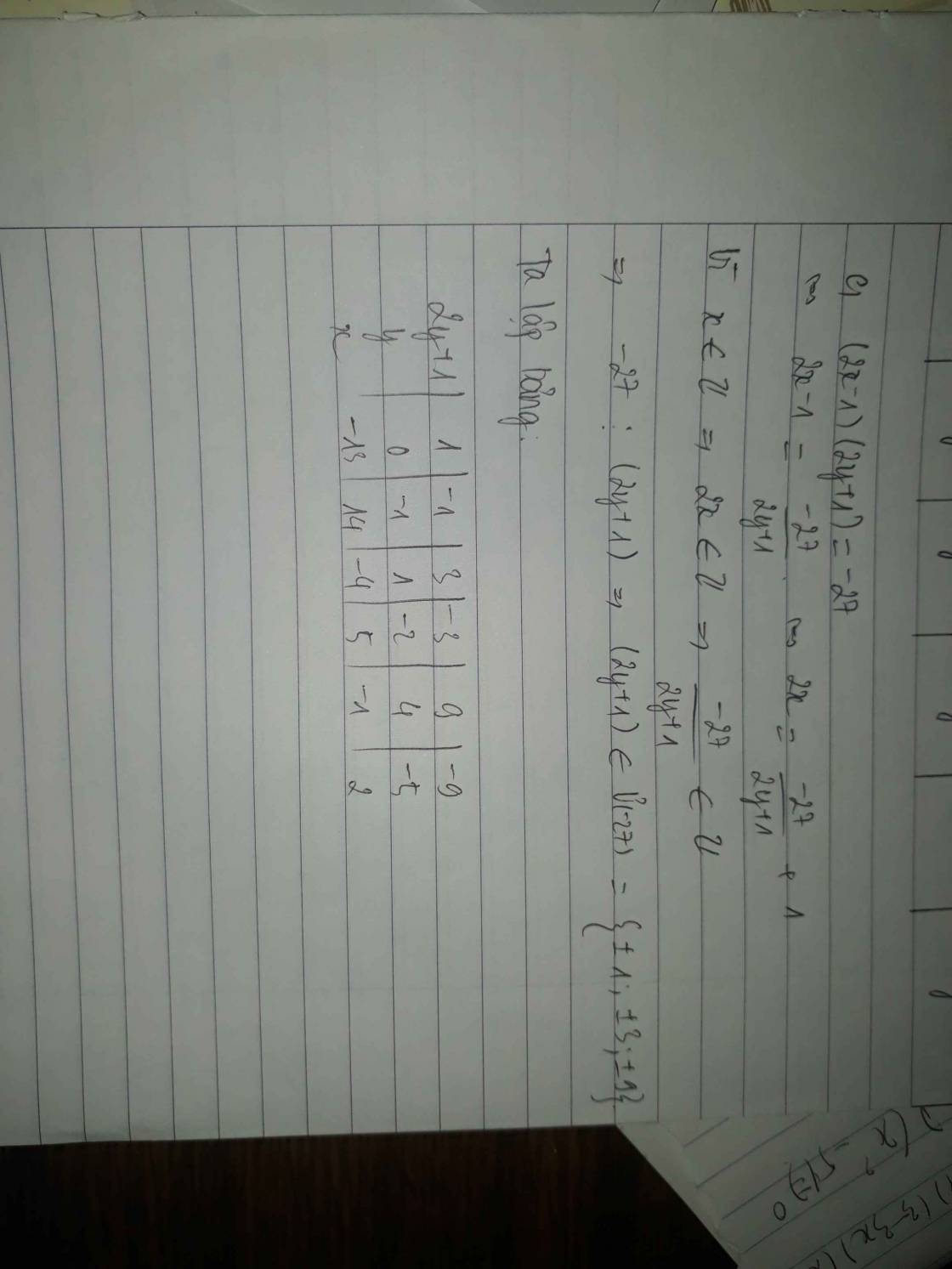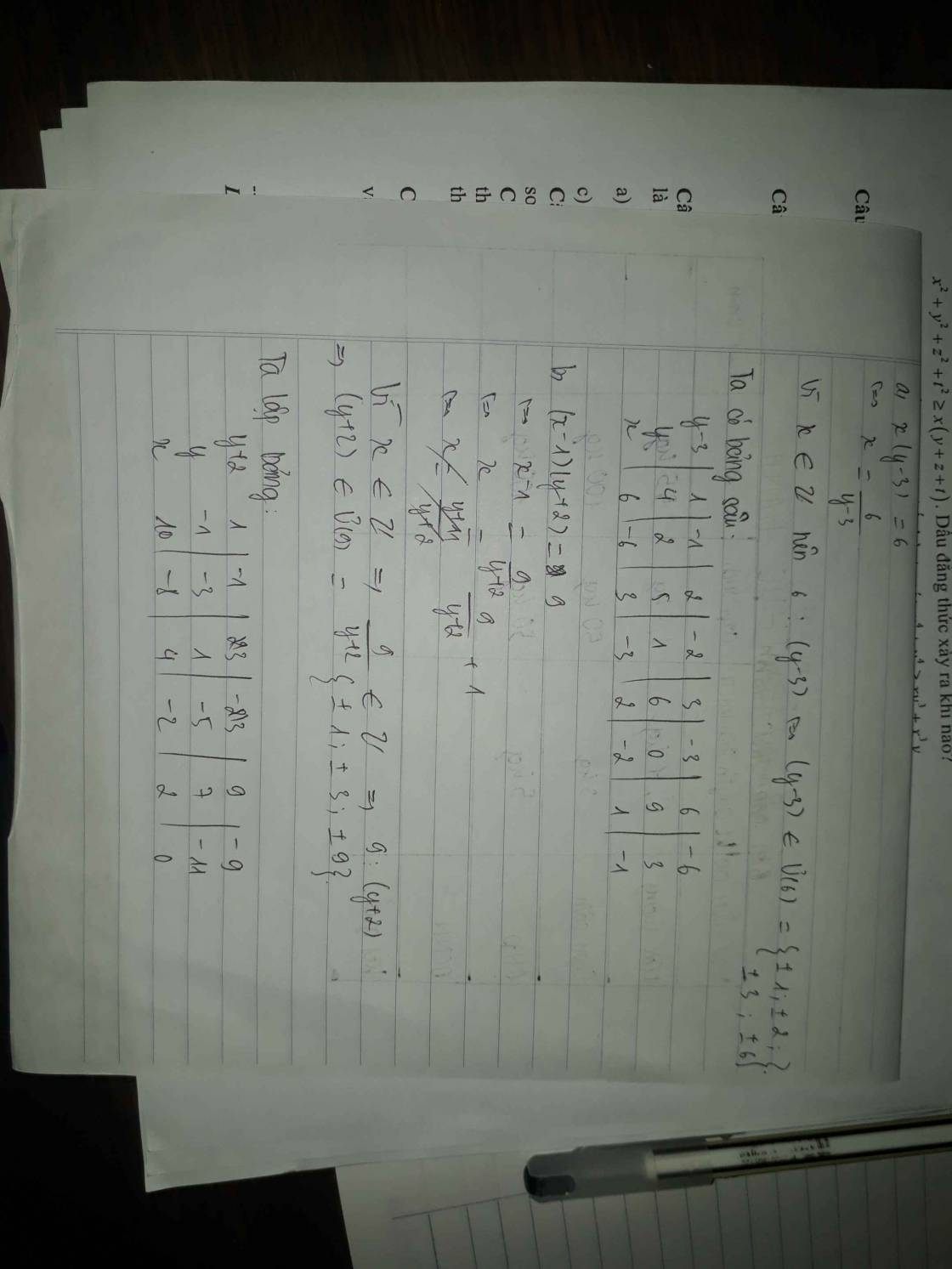Tìm tất cả các cặp số nguyên (x,y) biết:
a)x(y-3)=6
b)(x-1).(y+2)=9
c)(2x-1).(2y+1)=-27
Hãy nhập câu hỏi của bạn vào đây, nếu là tài khoản VIP, bạn sẽ được ưu tiên trả lời.




Bài 1
a) (x + 3)(x + 2) = 0
x + 3 = 0 hoặc x + 2 = 0
*) x + 3 = 0
x = 0 - 3
x = -3 (nhận)
*) x + 2 = 0
x = 0 - 2
x = -2 (nhận)
Vậy x = -3; x = -2
b) (7 - x)³ = -8
(7 - x)³ = (-2)³
7 - x = -2
x = 7 + 2
x = 9 (nhận)
Vậy x = 9

Lời giải:
Đặt $x+y=a; 3x+2y=b$ với $a,b\in\mathbb{Z}$ thì pt trở thành:
$ab^2=b-a-1$
$\Leftrightarrow ab^2+a+1-b=0$
$\Leftrightarrow a(b^2+1)+(1-b)=0$
$\Leftrightarrow a=\frac{b-1}{b^2+1}$
Để $a$ nguyên thì $b-1\vdots b^2+1$
$\Rightarrow b^2-b\vdots b^2+1$
$\Rightarrow (b^2+1)-(b+1)\vdots b^2+1$
$\Rightarrow b+1\vdots b^2+1$
Kết hợp với $b-1\vdots b^2+1$
$\Rightarrow (b+1)-(b-1)\vdots b^2+1$
$\Rightarrow 2\vdots b^2+1$
Vì $b^2+1\geq 1$ nên $b^2+1=1$ hoặc $b^2+1=2$
Nếu $b^2+1=1\Rightarrow b=0$. Khi đó $a=\frac{b-1}{b^2+1}=-1$
Vậy $x+y=-1; 3x+2y=0\Rightarrow x=2; y=-3$ (tm)
Nếu $b^2+1=2\Rightarrow b=\pm 1$
Với $b=1$ thì $a=\frac{b-1}{b^2+1}=0$
Vậy $x+y=0; 3x+2y=1\Rightarrow x=1; y=-1$ (tm)
Với $b=-1$ thì $a=-1$
Vậy $x+y=-1; 3x+2y=-1\Rightarrow x=1; y=-2$ (tm)

a) => 2xy +3x=y+1
=> 2xy+3x-y=1
=> x(2y+3) - 1/2 (2y+3) +3/2 =1
=> (x-1/2)(2y+3)=1-3/2= -1/2
=> (2x-1)(2y+3)=-1
ta có bảng
...........

\(\left(x-3\right)\left(x-12\right)=0\)
\(\Rightarrow\orbr{\begin{cases}x-3=0\\x-12=0\end{cases}}\Leftrightarrow\orbr{\begin{cases}x=3\\x=12\end{cases}}\)
\(\Rightarrow x\in\left\{3;12\right\}\)
\(\left(x^2-81\right)\left(x^2+9\right)=0\)
\(\Rightarrow\orbr{\begin{cases}x^2-81=0\\x^2+9=0\end{cases}}\Leftrightarrow\orbr{\begin{cases}x=9\\x\in\varnothing\end{cases}}\Leftrightarrow x=9\)
\(\Rightarrow x=9\)
\(\left(x-4\right)\left(x+2\right)< 0\)
\(\Rightarrow\hept{\begin{cases}x-4\\x+2\end{cases}}\)trái dấu
\(TH1:\hept{\begin{cases}x-4>0\\x+2< 0\end{cases}}\Leftrightarrow\hept{\begin{cases}x>4\\x< -2\end{cases}}\Leftrightarrow x\in\varnothing\)
\(TH2:\hept{\begin{cases}x-4< 0\\x+2>0\end{cases}}\Leftrightarrow\orbr{\begin{cases}x< 4\\x>-2\end{cases}}\Leftrightarrow x\in\left\{-1;0;1;2;3\right\}\)
Vậy \(x\in\left\{-1;0;1;2;3\right\}\)
